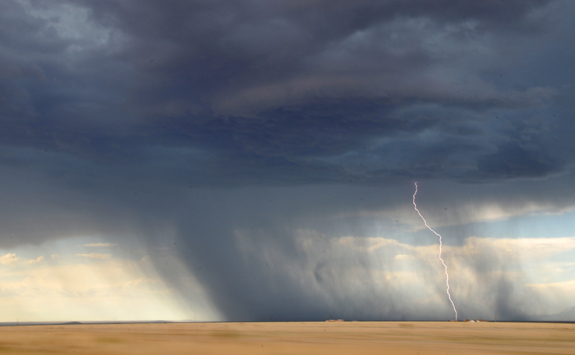Climate Research and Risk
Our research helps us to understand how our climate will change and its impacts on us and our environment.
Increasing our understanding of extreme weather
Our challenge is to help increase resilience against the impacts of climate change. These effects can include extreme weather events.
We're able to do that because we understand how the climate system works and how it might change in the future. We combine this with our expertise in how human and natural systems respond to change. We can then work out future levels of risk. This process depends on high-quality datasets and modelling tools.

We work to:
- develop new, high-quality datasets of climate observations
- understand the physical processes in the climate system that produce extreme weather events
- create the best modelling to understand future extreme weather events
- develop new approaches to combine information about hazards and vulnerability to quantify risk
Some examples of our research in this area:
Modelling extreme rainfall
We have developed stochastic rainfall models for a range of global climates. These models can be used to assess flood risk, water quality and agricultural productivity. Using a dynamic copula framework, we can assess the long-term impacts of change.
Our researchers have also worked with the UK Met Office. Together, we have developed a new generation of climate models. These models simulate how intense storms lead to flash floods. Using these models we have provided evidence of future increases in these storms.
Modelling floods
We have longstanding expertise in hydrological modelling. The SHETRAN model simulates water flow, sediment and solute transport in river catchments. It is helping to build a national modelling system for Great Britain.
We have developed a suite of state-of-the-art hydrodynamic modelling tools. Among these are the:
- High-Performance Integrated Modelling System (Hi-PIMS)
- City Catchment Analysis Tool (CityCAT)
We have also developed novel approaches to characterising flood impacts, such as:
- using network models to assess impacts on infrastructure
- using agent-based models to understand evacuation during flood events
We are also combining new remote sensing and other data with advanced analysis. Together, this improves flood risk management.
Understanding climate change
We have many years of experience in the analysis of extreme rainfall and its hazards. The worldwide research community uses our new, high-quality rainfall datasets. We have developed new processes for improving the quality of historical rainfall measurements. This produces high-quality datasets of global rainfall. Some of these products are now freely available and used by researchers and industry.
Our researchers have been able to shed new light on the nature and causes of extreme rainfall. This has helped us to better understand how it might change with global warming. A warmer atmosphere can hold more moisture, so we should expect increases in extremes.
As part of the INTENSE project, we examined rainfall records across Australia. As expected, they show that daily rainfall totals are increasing. But rain falling in short, intense storms is increasing at a rate two to three times higher than expected. This has implications for the future frequency and severity of flash floods. The changes we identified are not currently part of Australia's storm management plans.
Our work linking historical weather records and climate models helps us better understand storms and flash floods. This should mean improved infrastructure design.
Climate and infrastructure risks
The impacts of climate change can be severe. Climate models help us understand impacts from floods, heat waves, windstorms and droughts. Events like the 2003 European heat wave resulted in tens of thousands of deaths.
Researchers from our School of Engineering took part in the RAMSES project. They identified projections showing widespread worsening of heatwaves across European cities. They also showed a future increase in drought conditions, especially in southern Europe. There would also be increases in river flooding, especially in northwestern European cities.
Through analysis of historical climate data, we can better understand the hazards and risk. We can also improve the resilience of energy, road and rail infrastructure assets. A good example is the RESNET project. This looked at windstorms and the failure of the UK electricity distribution network.
This work shows how we can establish the impacts of climate change on infrastructure and our society. Our research shows we must adapt our infrastructure to cope with future conditions.
Climate and health risks
Soil erosion because of rainfall is a well-documented risk. Prolonged rainfall and livestock grazing can also mean more pathogens that affect humans.
These pathogens include Campylobacter, a major cause of gastroenteritis in the UK. Our researchers at the School of Natural and Environmental Sciences investigated this pathogen. Using modelling, they looked into Campylobacter infection rates in northeast England.
They found that campylobacteriosis was more likely with certain soil types. Other factors included the amount of overland water flow and heavy grazing. Understanding this could help us manage grazing systems to reduce potential problems in a changing climate.
Climate and cities
Cities are significant centres of consumption, using large amounts of resources and energy. Large populations and infrastructure exposed to extreme weather mean high climate risk.
Our researchers are investigating how heatwaves affect risk in large cities like London. They are using projections for climate change and economic and demographic growth. This will help show where we need to adapt infrastructure to improve climate resilience.
Newcastle researchers are developing new assessment frameworks for cities to incorporate this information. One example is the Urban Integrated Assessment Framework on the RAMSES project. It helps to assess risks related to pluvial floods, air quality and health. It also allows us to model climate impacts on the urban economy and infrastructure. Our framework is helping us to identify areas of London that are at risk. Applying the same approach will help create climate resilient infrastructure in other cities too.
Infrastructure modelling and assessment
Modern infrastructure systems are interdependent, relying on each other to function. Because of this, Newcastle University developed the National Infrastructure Systems Model Database. It is the first data platform of its kind in the world.
The database combines information on infrastructure networks and their inter-dependencies. This helps to assess failures between networks and highlight hotspots of infrastructure vulnerability. The information is crucial for climate change risk assessments.
